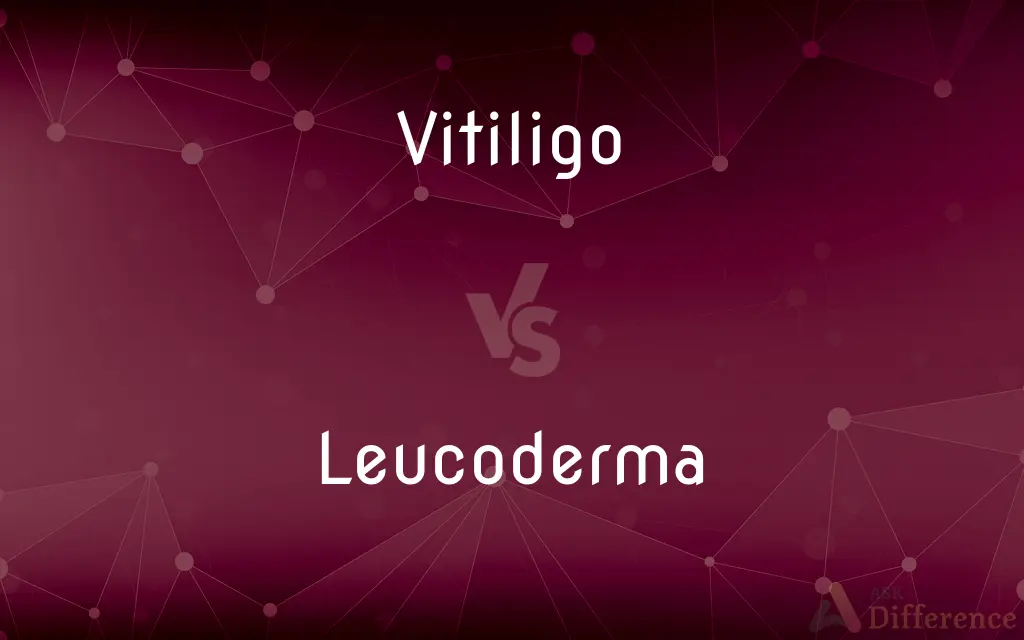Vitiligo vs. Leucoderma — What's the Difference?
Edited by Tayyaba Rehman — By Fiza Rafique — Updated on September 27, 2023
"Vitiligo" is an autoimmune condition causing skin depigmentation, while "Leucoderma" is a general term for white patches on the skin, of which Vitiligo is a type.

Difference Between Vitiligo and Leucoderma
Table of Contents
ADVERTISEMENT
Key Differences
Vitiligo and Leucoderma are terms often used interchangeably to describe skin conditions characterized by white patches. However, Vitiligo is a specific autoimmune disorder where the body's immune system attacks and destroys melanocytes, the cells responsible for skin pigment. In contrast, Leucoderma, derived from "leuco" meaning white and "derma" meaning skin, is a broader term that denotes any white or pale patch on the skin, and not necessarily from an autoimmune cause.
The primary feature of Vitiligo is the appearance of well-defined milky-white patches of skin, usually symmetrical, and often worsening with sun exposure. Leucoderma, however, could be caused by various factors, including burns, infections, or other inflammatory conditions. While Vitiligo is purely a loss of pigmentation without a known triggering event, Leucoderma may develop following an injury or ailment.
It's essential to distinguish between Vitiligo and other forms of Leucoderma, as the former requires a specific set of treatments targeting the immune response. On the other hand, some cases of Leucoderma, especially if post-inflammatory, might regain pigmentation without intervention or through different treatments.
Medical professionals often use the term Vitiligo to discuss the specific autoimmune condition, emphasizing its distinct cause and management. In contrast, Leucoderma serves as a descriptive term, detailing the symptom (white patches) rather than an exact diagnosis.
Comparison Chart
Definition
Specific autoimmune disorder causing skin depigmentation
General term for any white or pale patch on the skin
ADVERTISEMENT
Cause
Autoimmune destruction of melanocytes
Various causes, including trauma, burns, and infections
Symmetry
Often presents with symmetrical patches
May or may not be symmetrical
Treatment
Targets the immune response and repigmentation
Depends on the underlying cause
Diagnostic Implication
A specific diagnosis emphasizing its autoimmune nature
A descriptive term, not an exact diagnosis
Compare with Definitions
Vitiligo
An autoimmune skin disorder leading to depigmentation.
Her vitiligo started appearing during her teenage years.
Leucoderma
Can be caused by trauma, infections, or other skin conditions.
The infection left her with a patch of leucoderma.
Vitiligo
A condition where melanocytes are destroyed, causing white patches.
Doctors confirmed it was vitiligo after a thorough examination.
Leucoderma
A term describing white patches on the skin.
After the burn healed, he developed leucoderma on the affected area.
Vitiligo
Can worsen with sun exposure, leading to sunburn in affected areas.
She always uses sunscreen to protect her vitiligo patches from sunburn.
Leucoderma
White skin patches resulting from melanin loss.
He noticed leucoderma appearing where he had a scar.
Vitiligo
Often results in symmetrical white patches on the skin.
The symmetrical pattern of white patches suggested vitiligo.
Leucoderma
A descriptive term, not necessarily an exact diagnosis.
The dermatologist clarified that her leucoderma was, in fact, vitiligo.
Vitiligo
Can be segmental (restricted to one area) or non-segmental (widespread).
His segmental vitiligo was limited to one arm.
Leucoderma
Represents skin depigmentation without specifying a cause.
Leucoderma can be distressing for many due to its appearance.
Vitiligo
Vitiligo is a long-term skin condition characterized by patches of the skin losing their pigment. The patches of skin affected become white and usually have sharp margins.
Leucoderma
See vitiligo.
Vitiligo
A condition in which the pigment is lost from areas of the skin, causing whitish patches, often with no clear cause.
Leucoderma
(pathology) A loss of skin pigmentation, often in patches
Vitiligo
Partial or total loss of skin pigmentation, often occurring in patches.
Vitiligo
(dermatology) The patchy loss of skin pigmentation.
Vitiligo
(obsolete) Alphos, a form of leprosy.
Vitiligo
A rare skin disease consisting in the development of smooth, milk-white spots upon various parts of the body.
Vitiligo
An acquired skin disease characterized by patches of unpigmented skin (often surrounded by a heavily pigmented border)
Common Curiosities
Is Vitiligo hereditary?
While not strictly hereditary, there's a genetic predisposition in some cases.
Is Leucoderma always due to an autoimmune issue?
No, leucoderma is a general term and can be caused by various factors.
Can sun exposure worsen Vitiligo?
Yes, sunburn can occur on vitiligo patches and may worsen the condition.
Are treatments for Vitiligo and Leucoderma the same?
Not necessarily. Vitiligo treatments target the immune response, while leucoderma treatments depend on its cause.
Is Vitiligo a type of Leucoderma?
Yes, vitiligo is a specific type of leucoderma with an autoimmune cause.
Share Your Discovery

Previous Comparison
Lively vs. Animated
Next Comparison
Prologue vs. OvertureAuthor Spotlight
Written by
Fiza RafiqueFiza Rafique is a skilled content writer at AskDifference.com, where she meticulously refines and enhances written pieces. Drawing from her vast editorial expertise, Fiza ensures clarity, accuracy, and precision in every article. Passionate about language, she continually seeks to elevate the quality of content for readers worldwide.
Edited by
Tayyaba RehmanTayyaba Rehman is a distinguished writer, currently serving as a primary contributor to askdifference.com. As a researcher in semantics and etymology, Tayyaba's passion for the complexity of languages and their distinctions has found a perfect home on the platform. Tayyaba delves into the intricacies of language, distinguishing between commonly confused words and phrases, thereby providing clarity for readers worldwide.














































